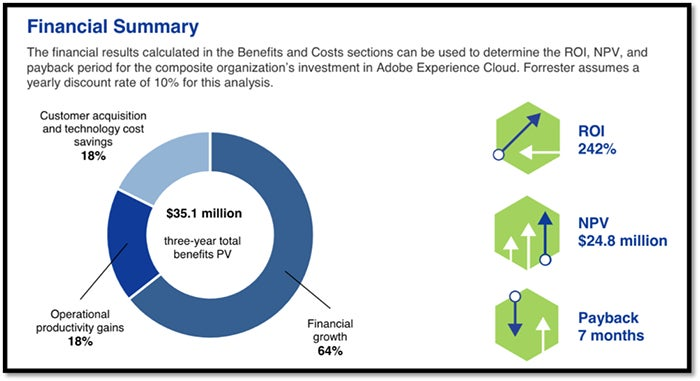While every brand knows that focusing on experience makes for a good customer story, they may question whether it makes for good business, too.
To answer that, Adobe last year commissioned a global Forrester Consulting study, titled “The Business Impact of Investing in Experience,” and the results were telling. Businesses that invested in creating great experiences — not just with technology, but with the people and processes required to support it — grew revenue 1.4x faster and improved customer lifetime value 1.6x more than companies that weren’t “all in” on experience. Customer retention rates were also 1.7x higher at experience-driven businesses, and even employee satisfaction — a critical precursor to the customer experience — grew by 1.5x.
In order for an organization to truly become an experience-driven business, every single person within the company must make customer-centricity a priority. This change in mindset and culture is imperative. Becoming experience-led also means overcoming challenges with siloed data, disparate and obsolete technology stacks, as well as manual processes — all of which require investment in order to address. Organizations need a strong business case as they decide where their experience-focused investments go. Understanding the impact of a solution that optimizes the customer experience — or, better yet, an integrated suite of customer experience management (CXM) solutions—is a prerequisite to signing on the dotted line.
That’s why Adobe recently went back to Forrester Consulting for a total economic impact (TEI) study about investments in Adobe Experience Cloud. Among the questions we wanted to address: What is the return on an Adobe Experience Cloud investment? What are the long- and short-term benefits? Where, specifically, are the efficiencies to be found? And in what ways will business impact be realized?
Forrester conducted detailed interviews with nine companies, spanning seven industries across various geographies. These companies use multiple Adobe Experience Cloud solutions, have above-average product adoption scores, and have been using these solutions for years within their marketing, customer experience, and analytics functions.
Through customer interviews and data aggregation, Forrester determined that the composite organization using Adobe Experience Cloud yielded a 242 percent ROI, with a lightning-fast seven-month payback period. They also increased their Net Promoter Score (NPS) by 14 percent. In addition, Forrester uncovered a number of compelling benefits that fell into three primary categories: financial growth, operational productivity, and customer acquisition and technology cost savings.
Financial growth
Image caption: NPV = Net Present Value; PV = Present Value.
Using Adobe Experience Cloud, companies saw 14 percent year-over-year (YOY) growth in new visitor traffic and a 25 percent increase in web and mobile conversion rates over three years. In addition, the study found that not only were these companies gaining new customers, but their current customers kept coming back, with 10 percent YOY loyalty program growth. Those same loyal customers actually purchased more from the companies, which saw a 60 percent increase in upselling conversion rates.
“Our conversion rates have improved dramatically… we went from less than 1 percent of new contacts converting to a marketing-qualified lead (MQL), and now we’re at 8 percent. Our conversion rate from MQL to sales-qualified lead (SQL) went from less than 1 percent to 10 percent,” said one participant in the study.
Operational productivity
Operational productivity was a second benefit Adobe Experience Cloud customers realized.
The ability to get the right messages to the right people at the right time makes all the difference in the world. Unfortunately, getting those messages and campaigns up and running can take time — and by the time they are built, they may no longer be relevant. With Adobe Experience Cloud, the companies studied were able to build marketing campaigns from scratch in about half the time it usually took using homegrown or legacy tools.
Equally important is the ability to serve up content while an opportunity is ripe. This means streamlining publishing processes and workflows — another benefit Adobe Experience Cloud customers realized.
“From a content velocity perspective, workflows that would previously have taken a week can now be done in 30 minutes using Adobe Experience Manager — things like setting up a new product page, for example,” said a director of marketing and communication. “With the ability to tie into our taxonomy and everything else, the speed that we’re able to deliver is multiples faster than we could ever do before.”
Furthermore, by creating richer, more contextually relevant digital “help” content, organizations empowered customers to use self-service options rather than interact with a service representative. This was a victory for both sides. Customers resolved issues faster, more efficiently, and had a better overall customer experience. At the same time, organizations lowered their overall customer care costs and increased productivity because call volume was reduced by 40 percent.
Customer acquisition and technology cost-savings
With Adobe Experience Cloud, organizations also benefited in technology and customer acquisition cost savings. By transitioning to one marketing stack, organizations were able to consolidate and retire legacy analytics and content management tools. In doing so, they saved on average over $2 million. Customer acquisition and agency costs dropped by 2.5 percent as organizations brought audience management in-house and eliminated reliance on outside agencies. Over the three-year period, customer retention jumped 2 percent, saving nearly $1.5 million in customer replacement costs.
“After picking Adobe Experience Manager as our platform, we estimate savings of about $2.5 million just in licensing cost, people cost, and the opportunity we would gain from consolidating onto one system,” said a participating chief digital officer.
Not only are companies realizing the benefits of being more customer-centric and experience-focused, they’re seeing the pressing need for it. Customers don’t just expect good experiences — they demand them. With Adobe Experience Cloud, experience-driven businesses reap the fruits of their investments in terms of providing amazing customer experiences while growing financially, gaining in operational productivity, and saving on technology costs.
To learn more about how experience-driven businesses are meeting the unique demands of their customers using Adobe Experience Cloud’s portfolio of products and services, check out Adobe’s ROI Page and download the full Forrester Total Economic Impact of Adobe Experience Cloud study.

